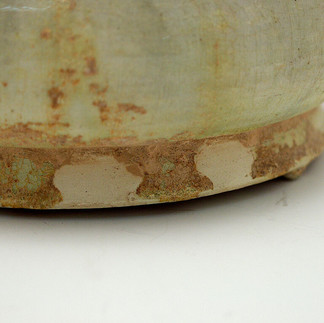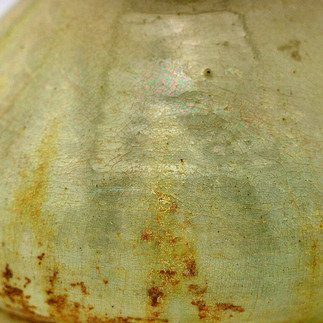北朝筆記 vol.29 哈佛大學博物館:南北朝響銅盤口壺 - Harvard University, Northern & Southern Dynasties Bronze (Sahari) Disk-Mouthed Vessel
- SACA
- Feb 12
- 7 min read

響銅是含錫量較多的青銅種類之一。以響銅製作的器物,具有「車削(轆轤)加工」和「鍛造加工」的明顯特徵,因其金屬質地緻密、敲擊時聲音洪亮,因此也被用來製作樂器。
在中國夏商周時代,社會與祭祀密不可分,因此曾以高超技術和珍貴材料,製作出大型或飾有精美紋樣、獨步於世界的青銅祭器。然而,自3世紀至4世紀以後,這類祭器逐漸不再製造,青銅轉而用於與日常生活相關的器物與佛具。
正是在這樣的時期,響銅器開始出現,最晚於5世紀左右便已有製作。從南北朝時代到唐代,可見瓶、盒、壺等實例。這些響銅器多半無紋飾,外形簡潔,與當時的銀器、陶瓷器一起,充分展現了那個時代的形式特徵。到了近世,響銅器仍持續生產,並逐漸成為主要用於樂器製作的金屬材質。
因此,可以認為響銅器是一種在中世至近世時期廣泛使用的青銅器。以往中國青銅器研究多著重於古代的彝器,但若將目光轉向響銅,或許能對自古代至近世的青銅器發展史,進行更完整連貫的理解。

材質(Material): 鍍銀青銅 / 或 青銅(響銅)
尺寸(Dimensions): 高 5.8厘米 × 直徑 6.2厘米(2 5/16 × 2 7/16 英寸)
來源(Provenance):
2001年1月於倫敦 Roger Keverne Limited 出售
加州伍德賽德 Walter C. Sedgwick Foundation (2000–2006)部分捐贈
2006年入藏哈佛大學藝術博物館
資金(Credit Line):哈佛藝術博物館/亞瑟‧M‧賽克勒博物館,承蒙 Walter C. Sedgwick Foundation 部分捐贈,並通過 Ernest B. and Helen Pratt Dane Fund for Asian Art 部分購買
館藏編號(Object Number): 2006.170.259
同款響銅盤口壺:
響銅壺
南北朝時代高 8.5厘米、胴(腹)徑 12.6厘米、底徑 10.3厘米

所謂「唾壺」,是用來盛放或棄置口中唾液的器具,自漢代起即已出現。南北朝至隋代間的唾壺,與本品類似,口部自壺身垂直向上。而至唐代初期,唾壺的口部則演變為類似漏斗的大口徑造型。
此壺通體呈現綠色銅銹,地金(金屬本色)被銹蝕所掩蓋。推測其製作工藝中使用了車削(轆轤)技法,故在口沿內外等處,可見到微弱的橫向切削痕跡。口沿的最外端輕微外傾,據此亦可判斷是透過車削成形。本作品未施加弦紋或七面(即凹曲面狀的溝槽),但其細部工藝正是響銅器所特有的表現手法。
本壺的胴部非正球形,而是略帶扁平,據此可推斷其製作年代約在南北朝時代後期。與東京國立博物館所藏的第17號唾壺不同的是,本器底部並非圈足,而是平底。內部形狀也與外部相稱,底面略低一階。
若無圈足而改用平底,意味著在製作程序上有所簡化,則此壺也可能是作為隨葬用的非實用品。
陶瓷同款:
北齊 黄釉盤口壺
哈佛大學藝術博物館藏
H. 16 x Diam. 14.6 cm (6 5/16 x 5 3/4 in.)
Provenance:[The Chinese Porcelain Company, New York, April 2000] sold; to Walter C. Sedgwick Foundation, Woodside, CA (2000-2006), partial gift; to Harvard University Art Museums, 2006.

Bronze Sahari Vase
On Sahari and the Overview of Chinese Bronzes
Sahari (響銅) is a variety of bronze with a relatively high tin content. A notable feature of objects made from Sahari is that they are processed by lathe turning and forging. Due to its dense metallic structure and the clear, resonant sound produced when struck, Sahari has also been used in the making of musical instruments. Besides East Asia, production of Sahari objects extended across wide regions of Southeast Asia and West Asia.
In ancient China, where society was closely tied to ritual worship, sophisticated techniques and precious materials were employed to create large bronze ritual vessels, often lavishly decorated with intricate designs. However, from the third to fourth century onward, such ritual vessels were no longer produced, and bronze came to be used for implements more closely linked to daily life as well as for Buddhist ritual instruments.
It was in this period that Sahari vessels emerged, with production beginning by at least the fifth century. From the Northern and Southern Dynasties through the Tang dynasty, extant examples include bottles, boxes, and jars. Featuring plain surfaces and simple forms, these Sahari vessels—alongside contemporary silverware and ceramics—embody the stylistic characteristics of the time. Even in later periods, Sahari vessels continued to be produced, gradually gaining recognition as the principal metal for making musical instruments.
Thus, Sahari vessels can be regarded as a type of bronze widely utilized from the medieval to early modern periods. Although the study of Chinese bronzes has traditionally focused on ancient ritual vessels (yíqì), paying attention to Sahari may enable us to develop a more continuous understanding of bronze-making history from ancient times through the early modern era.
Material: Silvered bronze / or Bronze (Sahari)Dimensions: H. 5.8 × Diam. 6.2 cm (2 5/16 × 2 7/16 in.)
Provenance:
Sold by Roger Keverne Limited, London, January 2001
Partially gifted by the Walter C. Sedgwick Foundation, Woodside, CA (2000–2006)
Acquired by the Harvard University Art Museums in 2006
Credit Line:Harvard Art Museums/Arthur M. Sackler Museum, Partial gift of the Walter C. Sedgwick Foundation and partial purchase through the Ernest B. and Helen Pratt Dane Fund for Asian Art
Object Number: 2006.170.259
Description of a Similar Sahari Pan-Kou Jar
Similar Sahari Pan-Kou Jar:Sahari Jar, Northern and Southern Dynasties periodHeight: 8.5 cm, body diameter: 12.6 cm, base diameter: 10.3 cm
A spittoon (Ch. tuo hu) is a vessel for collecting or discarding saliva, known to have existed since the Han dynasty. From the Northern and Southern Dynasties to the Sui dynasty, these spittoons typically had a mouth that rose vertically from the body, as seen in the present example. In the early Tang dynasty, the mouth evolved into a funnel-like form with a wide opening.
This jar’s surface is entirely covered in green patina, obscuring the underlying metal. Lathe-turning marks are faintly visible around the interior and exterior of the rim, suggesting that the piece was shaped by lathe work. The outer edge of the rim inclines slightly outward, further indicating lathe turning. Although this work does not feature any string-pattern bands or the so-called “seven facets” (concave curved grooves), the detailed finish is characteristic of Sahari vessels.
Because the body is somewhat flattened rather than perfectly spherical, the jar can be dated to the latter half of the Northern and Southern Dynasties period. Unlike the No. 17 spittoon in the Tokyo National Museum, which has a ring foot, this piece has a flat base. On the inside, the bottom surface is set slightly lower, following the external contour.
If the absence of a ring foot and the adoption of a flat base indicate simplified production steps, it is possible that this jar was made as a burial item rather than for daily, practical use.

響銅
響銅は錫を多く含む青銅の一種です。響銅製の器物は轆轤削りや鍛造で加工している点が大きな特徴で、緻密な金属質で叩くと響きがよいところから楽器にも使われます。東アジア各地のほか、東南アジア、西アジアなど広い地域で作られています。
中国古代では祭祀と不可分な社会であったことから、高度な技術と材料を駆使し、大型品や文様を凝らした青銅の祭器が作られました。しかし、3~4世紀以降そのような器物は作られなくなり、青銅は実生活に即した器物や、仏具に用いられるようになります。
このような時代に登場したのが響銅器で、遅くとも5世紀頃には製作が始まっています。南北朝時代から唐時代にかけて、瓶、盒、壷などの作例が見られます。無文で簡素な形姿の響銅器は、銀器、陶磁器とともにこの時代の形式特徴をよく表しています。近世においても響銅器は作られ、主として楽器に用いる金属として認識されるようになっていきました。
響銅器とは中世、近世において多用された青銅器と考えることができるでしょう。
中国青銅器の研究は古代彝器を取り上げることに力点が置かれていますが、響銅に注目することによって古代から近世にいたる青銅器の歴史を途切れなく理解することができるのではないでしょうか。

響銅壺 南北朝時代 高8.5cm、胴12.6cm、底径10.3cm
唾壺とは唾を捨てるための器で、漢時代より見られる。南北朝~隋時代には本品のような口が垂直に立ち上がっている器形をしており、唐時代はじめ頃より口が漏斗のような大きく開いた形に変化する。
全面が緑を呈しており、地金の色は錆下に隠れて見えない。轆轤挽きによると思われる横方向の削り目は、口縁の内外などにかすかに見られる。口縁の先端部分が外傾して作られており、これは轆轤削りによる成形と思われる。本作品には弦文や七面(凹曲面状の溝)は施されていないが、この細部の作りは響銅器独特の仕上げである。
球形でなく扁平気味の胴部の形態がこの壺の製作年代を示しており、南北朝時代後半ころのものと考えられる。
底部は東京国立博物館所蔵の17唾壺と異なり、圏足ではなく平底をなしている。内面はこの外形に沿って底面が一段低い形状になっている。
圏足を設けない平底の作りが製作手順の簡略化を意味するのであれば、非実用品の副葬品であった可能性があろう。















Comments